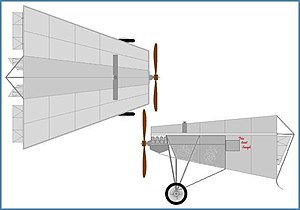Siamoperadectes
Siamoperadectes| Siamoperadectes 시간 범위:15–11 엄마 PreꞒ Ꞓ OSDCPTJKPg N↓ 중신세의 | |
|---|---|
| 과학적 분류 | |
| 킹덤: | |
| Phylum: | |
| 클래스: | |
| Infraclass: | |
| 패밀리: | †Peradectidae |
| 속: | †Siamoperadectes |
| 종류종 | |
| Siamoperadectes minutus Ducrocq(알. 1992년 | |
| 종 | |
| |
non-marsupial metatherian의 마이오세 태국의 Siamoperadectes은 유인원 속이다. 그 clade 남 아시아에서 알려진 Peradectidae의 일원, 그것은 첫 멤버로, 지난non-marsupial metatherians.
설명
Siamoperadectes의 형식 표본은 한개의 세번째 상위 대구치는 리 메이 롱 분지 북부 태국에서 발견된다.[1] 그것은 하각이 부족하고 대구치의moderately 날씬한 혀 부분 가장 가장 밀접하게peradectid metatherians에 연결하라 모든 특성을 가지고 있는 직선predilambdodont centrocrista을 표시합니다. 하지만 이것은 또한:몇가지 독특한 특성을 표시합니다.
-는 좁고 깊은 protofossa을 말한다.
-매우 약한 conules.
-1anteroposteriorly 압축 protocone.
그 metacone의 기지에-후천 치대다.
그 대구치, 인생에 아마 현대 Monodelphis 주머니 쥐. 유대목 주머니 쥐과의 크기 만한 육신으로 짐작될 것이다 작다. 비록 peradectids 전통적으로 기어오르는 습성이 있는 것으로 생각되어 왔다, 사실은 상대적으로 밀접하게 관련된 herpetotheriids terrestrial[2] 있지만 postcranial의 부족 Siamoperadectes에 남은 것을 이 추측을 비슷한 생활 양식을 줄 수 있다.
관계들
현재 Siamoperadectes은peradectid metatherian, 특히 밀접하게 Sinoperadectes과 Junggaroperadectes과 관련된 것으로 간주된다.[3] 슈퍼 didelphid은 원래의 paper,[1]에 설명한 현재 전반적인 여론은 peradectids crown-group Marsupialia,[4][5]의 바깥에 놓이며, 백악기 후기들의 외모 크게 유대류 내에 추정된 초기 발산 4,500만년 전 전에 건설된 것이다.[6]
생태
Siamoperadectes is known from the Miocene Li Mae Long deposits, which are rich on a variety of other mammal species such as the eulipotyphlans Thaiagymnura equilateralis, Hylomys engesseri, Neotetracus butleri and Scapanulus lampounensis, several rodents such as Diatomys liensis, the treeshrew Tupaia miocenica and several bats, ungulates and carniv지금까지 알려진 바로는,[7] 환경에 있는 모든 다른 포유동물들은 태클적인 에우테리아인이었다.
생물 지리학
Siamoperadectes는 가장 남쪽으로 알려진 peradectid이다.[1] 시노페라독테스, 융가로페르독테스 같은 중국 상피종과의 밀접한 관계는 그것이 인도 아대륙에서 진화하였기 보다는 라우라시아의 기원을 가지고 있었음을 시사하고 있으며, 아프리카와 인도 헤르페토테리아, 참 유대류와 함께 남부 대륙의 몇몇 신생 메타테리아 식민지를 대표하고 있다.
시간 범위
시아모페라데테스는 중국 시노페라데테스파와 함께 최연소 라우라시아 메타테리아인 중 한 명이며 남미 스파라소돈트 외에 확실히 마지막 비마르슈피알 메타테리아인 중 한 명으로, 1500만 년 전에서 1100만 년 전 사이에 미오세 중간부에 해당한다.[1] 전통적으로 태반 포유류와의 경쟁은 남아메리카와 호주 이외의 지역에서 메타테리아인들의 궁극적인 멸종의 주범으로 여겨져 왔지만, 이것은 특히 백악기와 신생아의 대부분을 통해 양쪽 성향이 공존하는 것에 비추어 볼 때, 의문에 부쳐졌다.[8][9] 적어도 헤르페토테리우스균은 미오세 중엽까지 상당히 흔했던 것으로 보이며,[10] 그 후 갑자기 사라진다; 아시아 지각변동이 곧 뒤따랐다.
Siamoperadectes가 멸종된 후, 호주에서 유래된 곰 쿠스쿠스(Allurops)가 인도네시아 섬들을 식민지로 삼았다.
참조
- ^ a b c d Ducrocq, Stephane; Buffetaut, Eric; Buffetaut-Tong, Haiyan; Jaeger, Jean-Jacques; Jongkanjanasoontorn, Yaowa-Lak; Suteethorn, Varavudh (1992). "First fossil marsupial from South Asia". Journal of Vertebrate Paleontology. 12 (3): 395–399. doi:10.1080/02724634.1992.10011468.
- ^ Sánchez-Villagra, Marcelo; Ladevèze, Sandrine; Horovitz, Inés; Argot, Christine; Hooker, Jeremy J.; Macrini, Thomas E.; Martin, Thomas; Moore-Fay, Scott; de Muizon, Christian; Schmelzle, Thomas; Asher, Robert J. (2007). "Exceptionally preserved North American Paleogene metatherians: adaptations and discovery of a major gap in the opossum fossil record". Biology Letters. 3 (3): 318–322. doi:10.1098/rsbl.2007.0090. PMC 2390683. PMID 17426007.
- ^ Ni, Xijun; Meng, Jin; Wu, Wenyu; Ye, Jie (2006). "A new Early Oligocene peradectine marsupial (Mammalia)from the Burqin region of Xinjiang, China". Naturwissenschaften. 94 (3): 237–241. doi:10.1007/s00114-006-0182-2. PMID 17136514.
- ^ Kielan-Jaworowska, Zofia; Cifelli, Richard L.; Luo, Zhe-Xi (2004). Mammals from the Age of Dinosaurs: Origins, Evolution, and Structure. New York: Columbia University. ISBN 0231509278.
- ^ Williamson, Thomas E.; Brusatte, Stephen L.; Carr, Thomas D.; Weil, Anne; Standhardt, Barbara R. (2012). "The phylogeny and evolution of Cretaceous–Palaeogene metatherians: cladistic analysis and description of new early Palaeocene specimens from the Nacimiento Formation, New Mexico". Journal of Systematic Palaeontology. 10 (4): 625–651. doi:10.1080/14772019.2011.631592.
- ^ Hubrecht, edited by Robert; Kirkwood, James (2010). The UFAW handbook on the care and management of laboratory and other research animals (8th ed.). Chichester, West Sussex: Blackwell Publishers. ISBN 978-1444318784.
{{cite book}}:first1=일반 이름 포함(도움말) - ^ Mein, P. 그리고 Ginsburg, L. L. 1997. Les mammiferes du gisement miocene inférieur de Li Mae Long, Taïlande : systématique, biostratigraphie et paléenvirnment. 지오디베리타스 19(4):783-844.
- ^ Sánchez-Villagra, Marcelo R. (2013). "Why are There Fewer Marsupials than Placentals? On the Relevance of Geography and Physiology to Evolutionary Patterns of Mammalian Diversity and Disparity" (PDF). Journal of Mammalian Evolution. 20 (4): 279–290. doi:10.1007/s10914-012-9220-3.
- ^ Carter, Anthony Michael; Mess, Andrea Maria (2013). "Conservation of placentation during the tertiary radiation of mammals in South America". Journal of Morphology. 274 (5): 557–569. doi:10.1002/jmor.20120. PMID 23355381.
- ^ Klietmann, J.; Nagel, D.; Rummel, M.; Hoek Ostende, L.W. van den (2013). "Amphiperatherium and Erinaceidae of Petersbuch 28". Bulletin of Geosciences. doi:10.3140/bull.geosci.1454.






